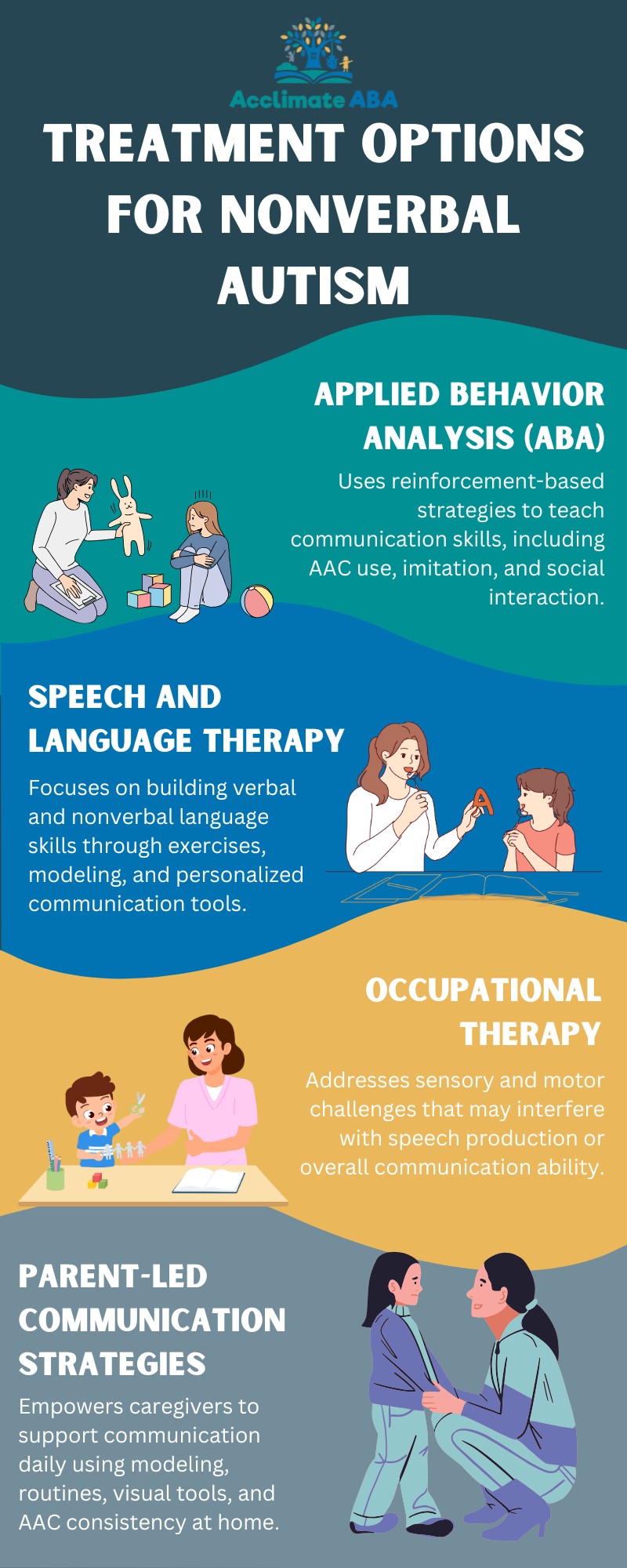Key Points:
- Nonverbal autism is not equivalent to intellectual disability; many individuals understand more than they can express.
- Causes may include motor planning issues, sensory processing difficulties, or co-occurring conditions like apraxia.
- Treatment often involves a combination of speech therapy, AAC tools, and ABA therapy tailored to communication goals.
Nonverbal autism affects a significant portion of the autism community. According to research, about 25–30% of autistic individuals remain minimally or nonverbal throughout life. This form of autism doesn’t reflect a lack of intelligence or awareness but rather differences in how individuals process and express language.
Understanding nonverbal autism means recognizing that communication can take many forms beyond speech. From AAC devices to gestures and facial expressions, these individuals often have rich inner lives and meaningful ways of connecting with others. In this article, we’ll explore symptoms, causes, and treatment options that empower nonverbal individuals to thrive.
What is Nonverbal Autism?
Nonverbal autism refers to individuals on the autism spectrum who do not use spoken language as their primary means of communication. While some may have no verbal speech at all, others might speak only a few words or phrases. The communication differences seen in nonverbal individuals are often misunderstood, but being nonverbal is not the same as lacking understanding or intelligence.
Many children and adults with nonverbal autism have strong receptive language skills—they can understand more than they can express. They may use gestures, vocalizations, or alternative communication systems to interact with others. Understanding these differences is key to supporting development.
What Are the Signs and Symptoms of Nonverbal Autism?
Children who are nonverbal often display signs early in life. These signs are related to expressive language challenges and may co-occur with other developmental differences. Importantly, the absence of spoken language doesn’t mean the absence of communication.
Here are some common indicators:
- No or minimal use of spoken words after age two or three
- Reliance on gestures or pulling to communicate needs
- Use of sounds or humming without structured speech
Parents might also notice that their child communicates in nonverbal ways, such as leading adults by the hand or using facial expressions and body movements.
What Causes Nonverbal Autism?
There isn’t one single cause for why some autistic individuals are nonverbal. Instead, several underlying neurological and developmental factors may contribute. Each person is different, and communication barriers can stem from a mix of physical, sensory, and cognitive variables.
Some common contributing factors include:
1. Motor Planning Challenges
Some nonverbal individuals experience apraxia, a motor planning disorder that makes it difficult to coordinate the physical movements needed for speech. This disconnect between intention and action can significantly impact spoken language development.
2. Sensory Processing Differences
Over- or under-reactivity to sensory input can affect how a child perceives and processes speech. Loud sounds, certain tones, or background noise may overwhelm or confuse, making verbal communication more difficult or less accessible.
3. Delayed Language Development
Some children with autism acquire language skills at a much slower rate. Without early intervention, they may continue to use only limited words or remain minimally verbal into adolescence or adulthood.
4. Cognitive Processing Differences
Difficulties in organizing, processing, or retrieving verbal information can limit speech. A child may understand language but struggle to produce spoken responses due to differences in how their brain handles communication.
5. Co-occurring Conditions
Neurological or medical conditions—like epilepsy, intellectual disability, or severe anxiety—can contribute to nonverbal autism. These overlapping diagnoses may complicate speech development and require multi-disciplinary support strategies tailored to each child.
Understanding that nonverbal autism is not a result of willful silence but often a result of physical or neurological obstacles can help caregivers provide better support.
How do Nonverbal Individuals Communicate?
Despite lacking fluent speech, many nonverbal autistic individuals communicate effectively using alternative methods. Parents and professionals should identify the most effective method based on the individual’s strengths and needs.
Common communication methods include:
1. Picture Exchange Communication System (PECS)
PECS allows individuals to communicate by handing or pointing to pictures that represent wants, needs, or ideas. It builds functional communication and can be especially helpful for children just beginning to use expressive language.
2. Speech-Generating Devices (SGDs)
SGDs are electronic tools that produce spoken words or phrases when a user selects symbols, pictures, or text. These devices offer a voice to nonverbal individuals and can support independent communication in daily interactions.
3. Text-Based Apps on Tablets
Many nonverbal individuals use apps that turn typed words into speech. These tools allow for flexible, spontaneous communication and are often customizable to suit vocabulary needs, reading levels, and personal preferences.
4. Sign Language or Adapted Signs
Some children and adults use sign language or simplified gestures to express themselves. These visual-kinesthetic forms of communication are particularly effective when paired with other methods like speech therapy or AAC.
5. Gestures, Facial Expressions, and Body Movements
Nonverbal individuals may rely heavily on nonverbal cues like pointing, facial expressions, or leading someone by the hand. While subtle, these gestures often convey clear intent and are essential components of their communication style.
Some children begin speaking after gaining confidence with AAC (augmentative and alternative communication), while others continue to rely on these tools as their primary communication method.
What Are Effective Treatment Options for Nonverbal Autism?
Treatment for nonverbal autism should be individualized and focus on improving overall communication, whether verbal or nonverbal. Interventions should build on the child’s strengths while addressing any underlying challenges that may be hindering speech or language development.
Here are several evidence-based approaches:
Can a Nonverbal Child Learn to Speak Later?
Yes, some children with nonverbal autism begin to develop speech later in life—sometimes during the school years or even adolescence. However, predicting speech outcomes is challenging, and progress varies widely. What’s most important is helping the child communicate, regardless of the method.
Supporting communication early with the right tools, therapies, and environment increases the chance of developing expressive skills—spoken or otherwise. And when children feel heard, their confidence and relationships grow stronger.
How Can Parents Support a Nonverbal Child at Home?
Supporting a nonverbal child goes beyond speech—it’s about building trust, reducing frustration, and offering consistent opportunities for expression. Creating a calm and responsive environment can empower children to communicate in ways that work best for them.
Here are some parent strategies:
1. Use Visual Schedules
Visual schedules provide structure and predictability, helping nonverbal children understand daily routines and upcoming transitions. They reduce anxiety, support comprehension, and empower children by giving them a clear sense of what comes next.
2. Respond to All Communication
Every communication attempt—whether a glance, gesture, or sound—is meaningful. Acknowledging and responding to these efforts encourages your child to keep engaging, showing them that their voice matters even without spoken words.
3. Model, Don’t Pressure
Instead of prompting speech directly, model clear, natural language during routines. This helps your child connect words with actions, making language more accessible without creating stress or performance pressure around speaking.
4. Use AAC Daily
Using AAC tools consistently during everyday activities helps your child see them as reliable communication methods. Modeling AAC use during meals, play, or errands shows its relevance and builds comfort over time.
5. Celebrate Every Step
Recognizing small communication milestones—like using a gesture or symbol—boosts confidence and reinforces learning. Celebrating progress, no matter how minor, shows your child that every effort to connect is valuable and appreciated.
When Should Families Seek Support?
Families should seek support as soon as they notice delayed speech, limited communication, or social engagement challenges—ideally by age two. Early intervention can make a significant difference in building communication skills and reducing frustration for both the child and caregivers.
Even without a formal autism diagnosis, speech therapy, developmental evaluations, or ABA consultation can help guide the next steps. The earlier support begins, the more opportunities a child has to develop expressive tools—whether through speech or AAC. Early action empowers families with strategies tailored to their child’s needs and promotes long-term growth in connection and communication.
Build Lasting Skills With ABA Therapy
Families raising nonverbal autistic children deserve support that’s both compassionate and evidence-based. At Acclimate ABA, we provide personalized ABA therapy in Utah that focuses on helping children build meaningful communication, whether through speech, signs, or technology.
Our team collaborates with families to reduce communication frustration and foster growth across environments. ABA therapy can be adapted to support AAC use, encourage interaction, and promote self-expression.
Get in touch with us to learn how we can support your child’s journey toward confident communication.



